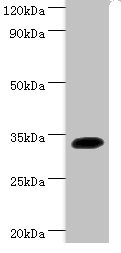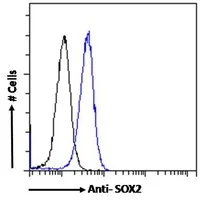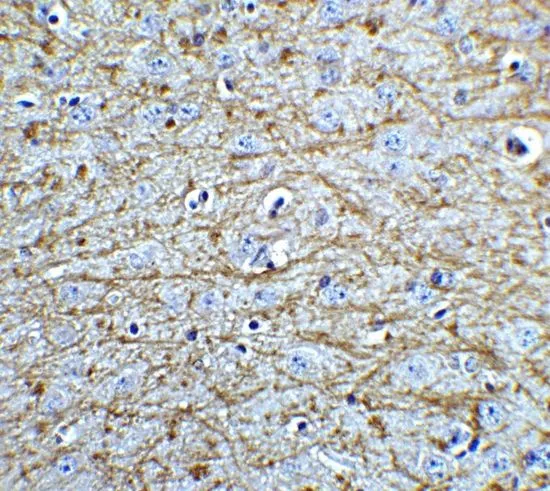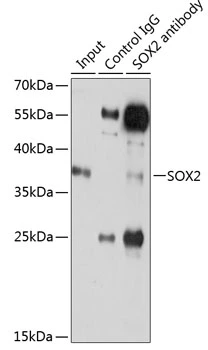SOX2 antibody [GT1876]
GTX627404
ApplicationsFlow Cytometry, ImmunoFluorescence, ImmunoPrecipitation, Western Blot, ImmunoCytoChemistry, ImmunoHistoChemistry, ImmunoHistoChemistry Frozen, ImmunoHistoChemistry Paraffin
Product group Antibodies
TargetSOX2
Overview
- SupplierGeneTex
- Product NameSOX2 antibody [GT1876]
- Delivery Days Customer9
- Application Supplier NoteWB: 1:500-1:10000. IHC-Fr: 1:100-1:1000. FACS: 1:50-1:200. IP: 1:100-1:500. *Optimal dilutions/concentrations should be determined by the researcher.Not tested in other applications.
- ApplicationsFlow Cytometry, ImmunoFluorescence, ImmunoPrecipitation, Western Blot, ImmunoCytoChemistry, ImmunoHistoChemistry, ImmunoHistoChemistry Frozen, ImmunoHistoChemistry Paraffin
- CertificationResearch Use Only
- ClonalityMonoclonal
- Clone IDGT1876
- Concentration1 mg/ml
- ConjugateUnconjugated
- Gene ID6657
- Target nameSOX2
- Target descriptionSRY-box transcription factor 2
- Target synonymsANOP3, MCOPS3, transcription factor SOX-2, SRY (sex determining region Y)-box 2, SRY-box 2, SRY-related HMG-box gene 2, sex determining region Y-box 2, transcription factor SOX2
- HostMouse
- IsotypeIgG1
- Protein IDP48431
- Protein NameTranscription factor SOX-2
- Scientific DescriptionThis intronless gene encodes a member of the SRY-related HMG-box (SOX) family of transcription factors involved in the regulation of embryonic development and in the determination of cell fate. The product of this gene is required for stem-cell maintenance in the central nervous system, and also regulates gene expression in the stomach. Mutations in this gene have been associated with optic nerve hypoplasia and with syndromic microphthalmia, a severe form of structural eye malformation. This gene lies within an intron of another gene called SOX2 overlapping transcript (SOX2OT). [provided by RefSeq]
- Storage Instruction-20°C or -80°C,2°C to 8°C
- UNSPSC12352203
References
- Selective Proliferation of Highly Functional Adipose-Derived Stem Cells in Microgravity Culture with Stirred Microspheres. Mashiko T et al., 2021 Mar 4, CellsRead more
- Upregulation of CD109 Promotes the Epithelial-to-Mesenchymal Transition and Stemness Properties of Lung Adenocarcinomas via Activation of the Hippo-YAP Signaling. Lee KY et al., 2020 Dec 25, CellsRead more
- A novel integrated system using patient-derived glioma cerebral organoids and xenografts for disease modeling and drug screening. Zhang L et al., 2021 Mar 1, Cancer LettRead more
- Identification of novel susceptibility loci for non-syndromic cleft lip with or without cleft palate. Ma L et al., 2020 Dec, J Cell Mol MedRead more
- The acidic tumor microenvironment drives a stem-like phenotype in melanoma cells. Andreucci E et al., 2020 Oct, J Mol Med (Berl)Read more
- Mitochondrial DNA alterations may influence the cisplatin responsiveness of oral squamous cell carcinoma. Aminuddin A et al., 2020 May 12, Sci RepRead more
- Generation of Stable Induced Pluripotent Stem-like Cells from Adult Zebra Fish Fibroblasts. Peng L et al., 2019, Int J Biol SciRead more
- Thyroid hormone negatively regulates tumorigenesis through suppression of BC200. Lin YH et al., 2018 Dec 1, Endocr Relat CancerRead more
- Non-Canonical Regulation of Type I Collagen through Promoter Binding of SOX2 and Its Contribution to Ameliorating Pulmonary Fibrosis by Butylidenephthalide. Chuang HM et al., 2018 Oct 4, Int J Mol SciRead more
- Stress stimuli induce cancer-stemness gene expression via Sp1 activation leading to therapeutic resistance in glioblastoma. Chang KY et al., 2017 Nov 4, Biochem Biophys Res CommunRead more




![ICC/IF analysis of NTERA-2 cells using GTX60381 SOX2 antibody [10F10]. Green : SOX2 Red: Actin filaments](https://www.genetex.com/upload/website/prouct_img/normal/GTX60381/GTX60381_20170912_ICCIF_w_23061123_336.webp)
